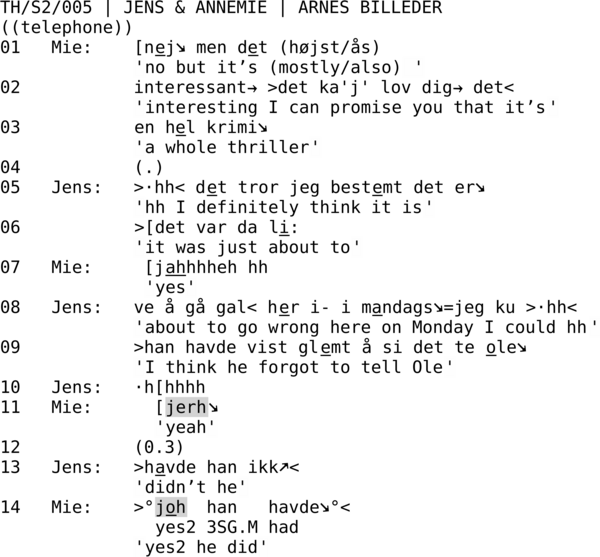Yes2
This entrance is about the answer token or interjection jo, which does not have a direct English translation, but which we have chosen to call ‘yes2’. This response token is used as a response to both questions and other utterances. It is normally stressed and can be pronounced as ['joːˀ], ['jɔwˀ].
Danish has a so-called ‘perfect polarity system’ which means that negatively formulated utterances are confirmed with nej ‘no’, while positively formulated utterances are confirmed with ja ‘yes’. However, in some cases, a positive claim is expressed through a negatively formulated utterance. In those cases, jo is used to to confirm or disconfirm the claim. The example below illustrates the clear difference in the usage of ja and jo. In the example, a positively formulated utterance is confirmed with a ja, but when the same utterance is rephrased negatively a while later, it is confirmed with jo:

Mie and Jens are gossiping about a local family and Mie has just told Jens that the family members have had a falling out due to an inheritance issue. In lines 4-7 Jens makes a statement to Mie about one of the family members having forgotten to inform another family member of something. The use of vist in line 7, which translates literally to something like ‘surely’, but in use means something more like ‘I think’, suggests that Jens has less knowledge than Mie about the subject, but Mie’s jerh ‘yeah’ on line 9 only expresses confirmation towards the statement, not that she has more knowledge of the subject. Following this, Jens produces a negatively formulated question on line 11 which shows that he wants his statement confirmed. Mie confirms in line 12 with joh han havde ’yes2 he did’.
Jo is also used to confirm utterances which are negatively formulated by virtue of the tag ikk ‘right’ at the end of the utterance. This is the case in the example below where Lis’ claim that Asta had a common car in the garage is finished with ikk ‘right’:
![SAMTALEBANK | SAM2 | SAMFUNDSKRISE| L494 ((face-to-face)) 01 AST: jamen ▔vi▔ fik ikk bil før i halvfjerds jo↘ 'but we didn’t get a car before ’70 you know' 02 (0.6) 03 AST: °enoghalvfjerds°↗ 'seventy one' 04 (1.0) 05 LIS: amen i havde da den fælles der holdt 'but you had the communal one that was parked' 06 herude i garagen ikk↗ 'out here in the garage right' 07 (0.4) 08 LIS: holdt [den ikk her] hos jer↗ 'wasn't it parked here at your place' 09 AST: [jo::→ ] yes2 10 (0.2) 11 AST: øh: jo↘ uh yes2 12 (.) 13 AST: det gjorde den↘ 'it did' 14 LIS: ja[: ]→ 'yes' 15 AST: [men] det var ikk sån vores egen jo↘ 'but it wasn’t, like, our own you know' 16 (0.8) 17 LIS: det var ikk en i måtte køre i t(h)il århus∾ 'it wasn’t one you were allowed to drive to århus' 18 huhuh°huh° ∙hhhh 19 AST: jo men vi gjorde det jo ikk↗ yes2 but 1PL did it JO not 'yes but we didn’t do it you know'](/fileadmin/_processed_/d/9/csm_yes2_2_43690beacd.png)
The first jo ‘yes2’ uttered by Asta, in line 9, is quite delayed (see the pause in line 7) but clearly functions as an answer to Lis’ utterance in lines 5-6 where the tag ikk ‘right’ is placed at the end of the utterance. Yes2 can thus be used to confirm positively formulated utterances when they end with the tag ikk.
Perhaps due to Asta’s delayed answer, Lis reformulates her utterance to a negative question in line 8, which expresses her expectation that the car was parked in Astas garage. Again, Asta confirms this with jo in line 11.
Finally, this last example also shows that yes2 can disconfirm or contradict negatively formulated sentences. In line 19 jo is a part of the turn-initiating particle jomen, in which jo disconfirms the negatively formulated expectation (that Asta ‘was allowed to’ drive the car to Aarhus, but only partly, hence the but-part of the utterance).
Soruces and further reading
Heinemann (2003) is a ph.d.-thesis which describes the use of nej ‘no’ in a variety of situations, and also includes a chapter on jo ‘yes2’. The thesis has since been published in Skrifter on Samtalegrammatik 2(12) as Heinemann (2015).
Heinemann (2005) is about the ’perfect polarity system’ in Danish and therefore describes the use of ja, nej og jo.
Relevant entries
The Building Blocks of Talk-in-interaction > Word classes > Interjections and particles
